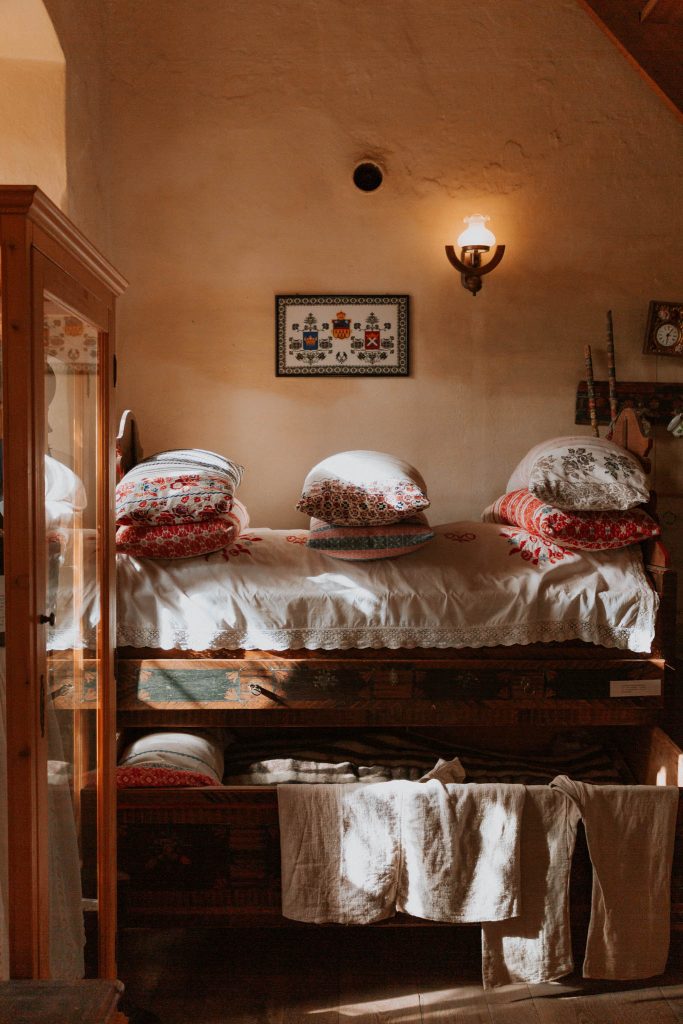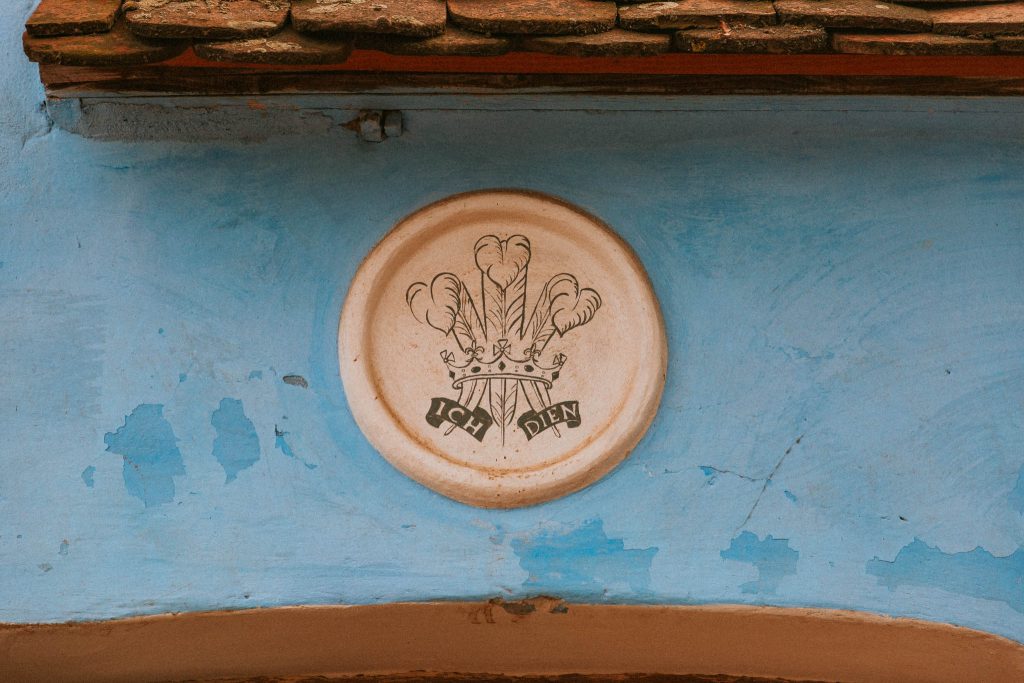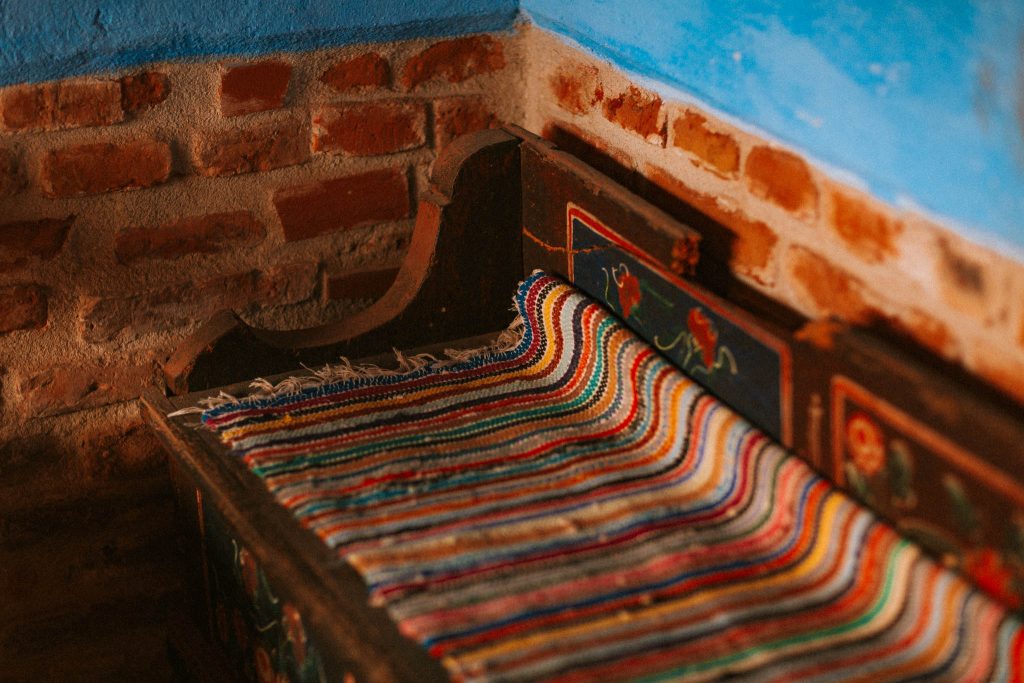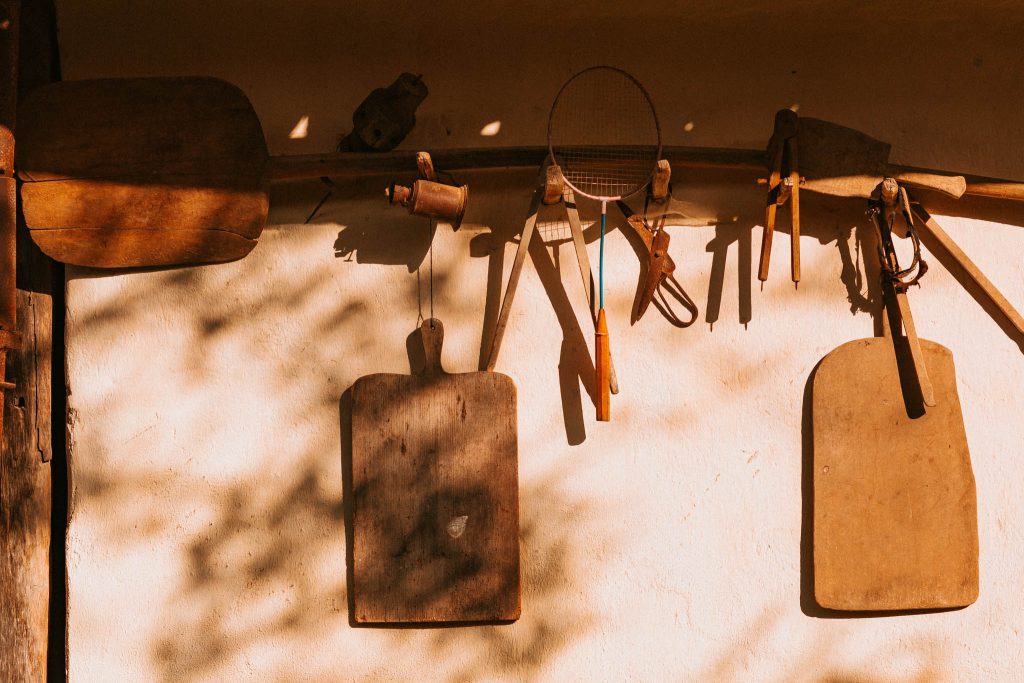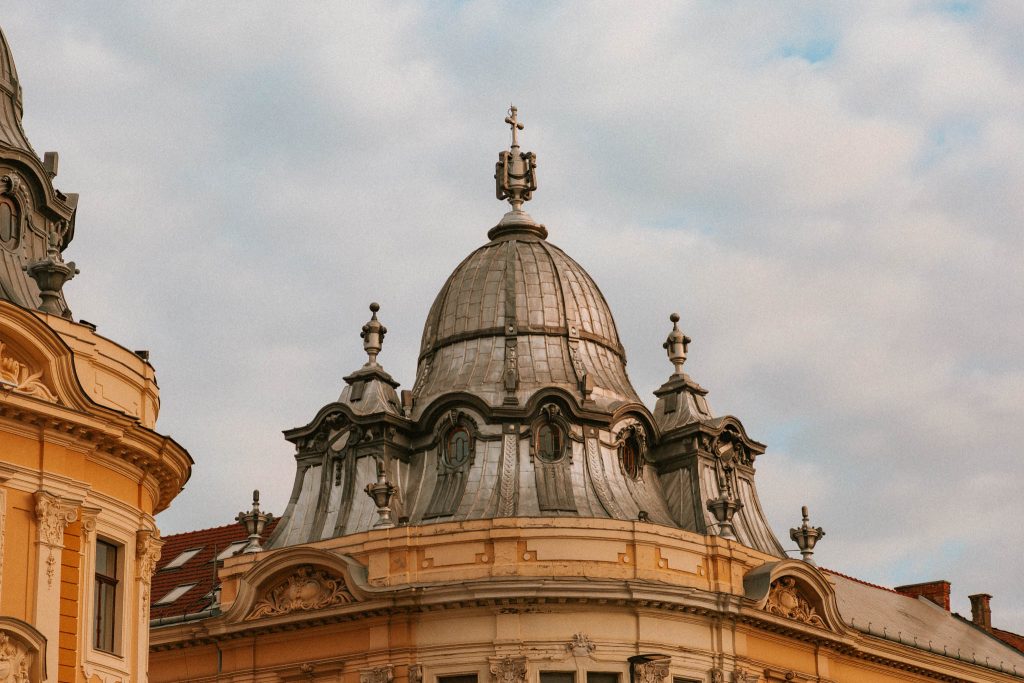This itinerary for a one week Halloween road trip through Transylvania contains affiliate links.
In October 2024, we led our sixth tour – this time to Romania.
At first glance, it may have seemed an odd choice. After all, our previous adventures had taken us to the vast deserts of Wadi Rum, the ancient skylines of Uzbekistan, and the buzzing souks of Morocco.
Romania? It seemed a bit, well – lack lustre – in comparison.
However, once I’d explained the timings of the road trip – late October, just as Halloween approached – it all made sense. We were headed to Transylvania, the mythical homeland of Dracula and the unofficial Halloween capital of the world.
Our initial plans were, admittedly, a bit ghoulish. When researching the best places to visit in Transylvania, we mapped out misty cemeteries, night time tours and of course, Bran Castle – Dracula’s Castle. We imagined shadowy inns, cawing crows, and plenty of ghouls.
However, the deeper we dove into our planning, the more Romania surprised us.
What began as a spooky-season road trip quickly became something far more beautiful. Transylvania in autumn is, quite simply, stunning: golden forests ablaze with colour, snow-dusted mountains rising in the distance, and ancient towns alive with folklore.
By the end of our own week-long road trip around Transylvania in autumn, we were completely bowled over– not by Dracula, but by the landscapes, the people, and the sheer beauty of the place. Halloween may have brought us to Transylvania, but it was everything else that made us want to stay.
Below is our full itinerary for a week’s road trip through Transylvania, including the unmissable places to visit in Transylvania.
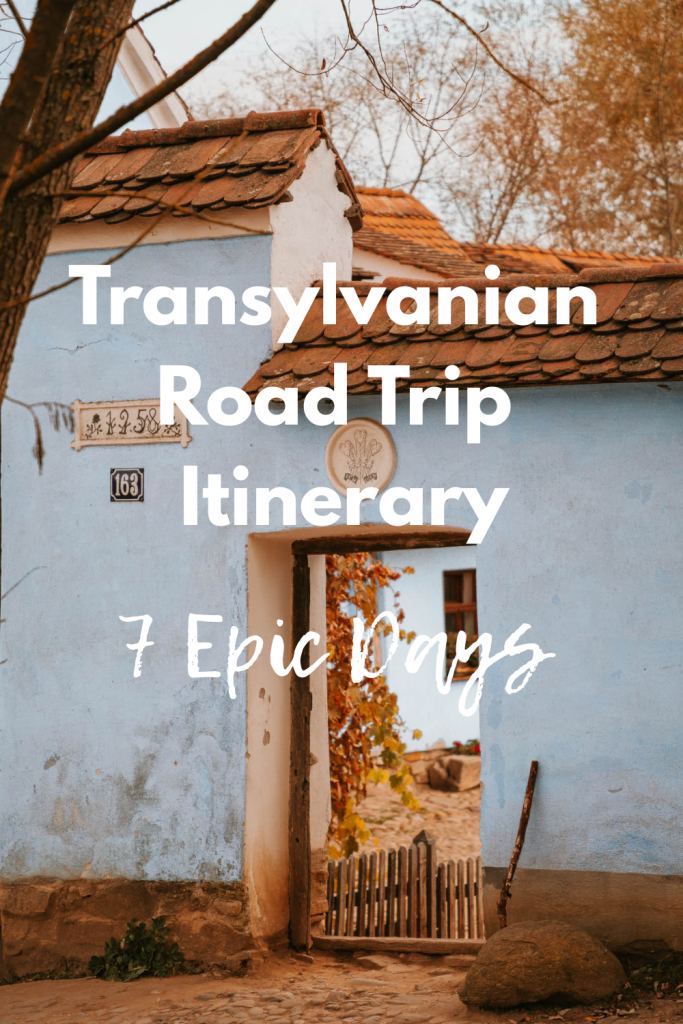
Transylvania Road Trip Itinerary: 7 Days
Where to Start a Road Trip in Transylvania?
If you’re flying from the UK, you can travel straight to the heart of Transylvania with direct flights to Brasov or, if doing this itinerary in reverse, Cluj-Napoca.
However, we decided to begin our journey in Bucharest – not just for convenience, but because we hadn’t yet explored this often-overlooked European capital.
It turned out to be the perfect launchpad for our Transylvanian road trip.
Book your flights to Bucharest here
Car Hire in Transylvania
A quick note on our own road trip itinerary: we actually travelled via a mini bus (there were 15 of us), rather than drove ourselves. However, roads in Romania seemed pretty good if you do want to drive, although they can get very congested along the more popular tourist routes.
Additionally, if you visit the smaller, medieval towns, then the roads can get very narrow and parking is tricky. I’d therefore recommend getting a mid-size or small car, just to save yourself the stress of parking a truck in a space designed for a donkey.
Also be sure to hire a care from one of the main airports – Bucharest or Cluj Napoca. These have the usual car hire providers, such as Hertz, Europcar, Sixt, etc., along with competitive pricing. You can also hire a car from Brasov airport, but definitely book ahead of time and check availability, as there is a smaller offering.
Conversely, in terms of the cost of hiring a car in Romania, it’s actually probably cheaper to hire from smaller destinations such as Brasov. On average, a small hire car from here will set you back £260 for the week, while hiring from Bucharest can be up to £150 more expensive.
Also remember that if you’re returning the car to a different destination, you’ll often have to pay extra.
1 Week Halloween Transylvania Itinerary: The Best Places to Visit in Transylvania
Day 1: Bucharest
As I mentioned above, there are multiple places to begin your Halloween road trip through Transylanvia. However, and after a bit of back and forth, we decided to begin in Bucharest.
While not part of Transylvania, it is Romania’s capital city and fascinating in its own right, so we thought it was definitely deserved a visit. Plus flights to Bucharest from the UK are regular and (often) cheap.
Flying to Bucharest
We flew from Luton airport and our flights cost £240 with Wizz Air. I was quite surprised by this price and expected them to be much cheaper. However, we were flying during the school holidays and you can get return flights for as little as £75.
Leaving bright and early, we landed in an unexpectedly warm Bucharest by lunch time. Hopping in a taxi, we were at our hotel an hour later.
Where to Stay in Bucharest
On a budget, we stayed at the Continental Forum, a short walk from the city’s Goliath like Palace of the Parliament. Clean, quiet and around £90 a night for a double room, this is a great option for any visitors looking for an frugal stay.
Given that we were rarely in our rooms, it was absolutely fine – and really comfortable.
If I was staying in Bucharest a little longer, I’d have perhaps splurged on one of the city’s more romantic hotels. During our own visit, we popped into the Marmorosch Bucharest – a 5* hotel in the city centre, and I have to admit – it was stunning inside (I was slightly envious of those staying).
Prices are very reasonable, around £180 a night in October – if you’re taking your Transylvania road trip during Halloween.
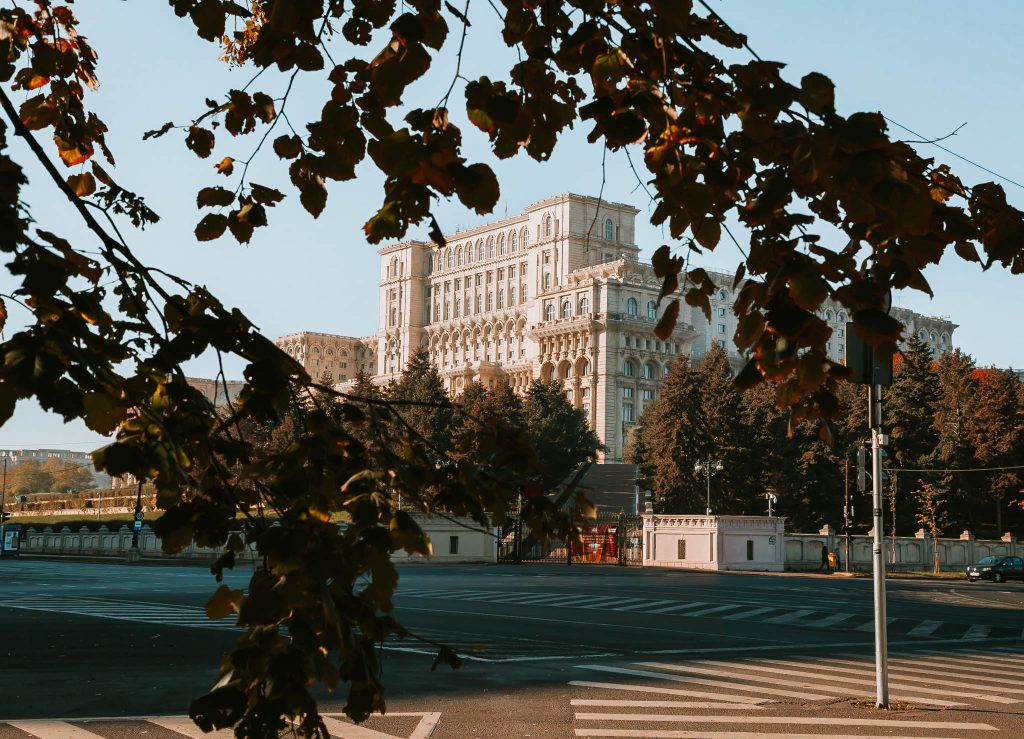
First Evening in Bucharest
After freshening up and unpacking, we headed into Bucharest to explore.
Our hotel was conveniently close to the Palace of the Parliament and so we decided to head there first, just to see it from the outside. A colossal building, the Parliament was the pipe dream of notorious Romanian dictator, Nicolae Ceaușescu, and work began on it in 1984.
One of the most expensive administrative buildings ever constructed, this vast building – built using the country’s money during a period of famine – remains the heaviest and second-largest administrative building in the world.
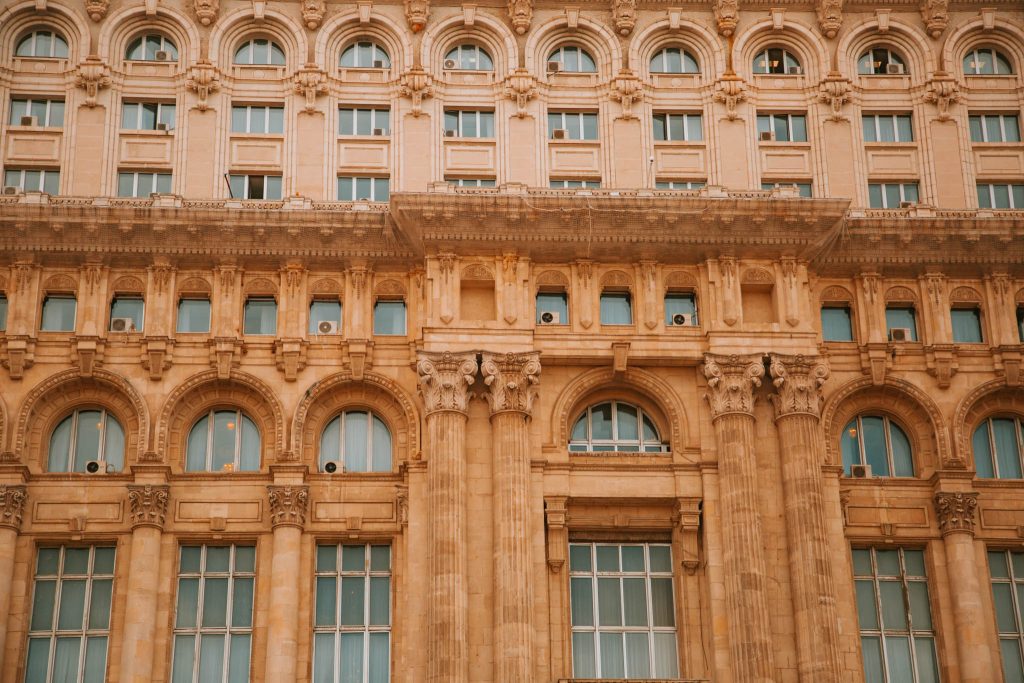
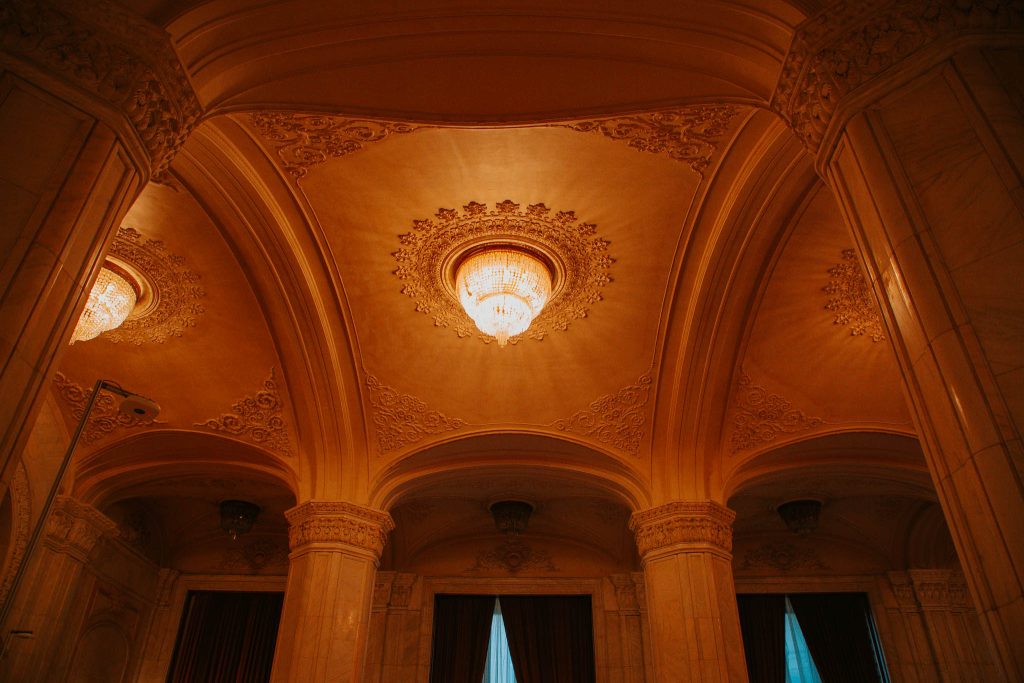
Featuring 1,100 rooms (and 8 underground floors), the Palace is indicative of the dictator’s megalomaniac vision – and utter disregard for the Romanian people.
Rather than visit the Palace that afternoon (there’s a lot to see), we instead headed for dinner at a nearby restaurant – Haute Pepper – serving Italian and Romanian food (including incredible Transylvanian red wine, to get us in the spirit of things).
The interiors were beautiful and the food was great. It was a fantastic way to kick-start our 7 day Transylvania road trip.
Day 2: Exploring Bucharest
As part of our Transylvania road trip itinerary, we decided to spend the second day exploring Bucharest.
This city – a surprising blend of Parisian flair and Soviet brutality – often flies under the tourism radar, many of whom often hop on a little further to Tallinn or Riga).
However, it’s a worthy destination in its own right, and often referred to as ‘Little Paris’ for its wide boulevards and tree-lined streets. The city is also home to acres of green space and boasts over 20 parks, including the famous Herăstrău Park (the biggest in the city) and the historic Cișmigiu Gardens, opened in 1847.
When we visited during the autumn, the skies were skill a vivid blue and golden leaves swept through the streets, making it a surprisingly romantic city.
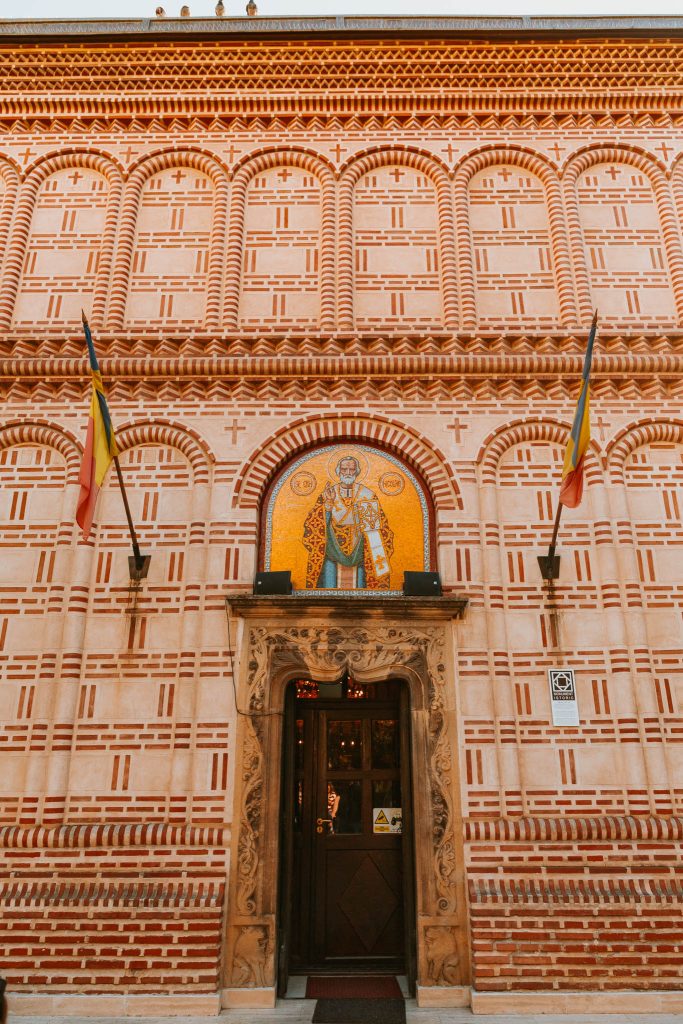 Explore Bucharest’s Old Town
Explore Bucharest’s Old Town
We began with a walk past the Palace of Parliament towards a quiet corner of the city, filled with a smattering of the city’s Roman Orthodox Churches.
As it was a Sunday, the churches were filled with churchgoers and we sat watching as families lit candles for loved ones outside. As hymns rang out across their gardenia-filled courtyards, I felt surprised at this introduction to Bucharest.
It was gentle, calm and well, very pretty.
Following our guide, we left this peaceful patch and made our way over to Bucharest’s Old Town – or Centrul Vechi.
The oldest part of the Old Town dates back to the 15th century and reflects a time when Bucharest was home to the courts of Wallachia (including, of course, the infamous Vlad the Imapler).
Down its narrow alleyways you’ll find hidden churches, ancient inns, guild halls and coffee houses – each drenched in its own portion of Romanian history.
Sites worth visiting include Stavropoleos Church, a tiny but beautiful Orthodox monastery from 1724, the Old Princely Court & Church, which happens to be the old palace of Vlad the Impaler and Manuc’s Inn – a gorgeous 19th-century caravanserai (a type of roadside inn), which is now a restaurant and hotel.
We really enjoyed our tour around this historic part of Bucharest. Not only incredibly beautiful, it revealed an incredibly rich history that I perhaps hadn’t anticipated.
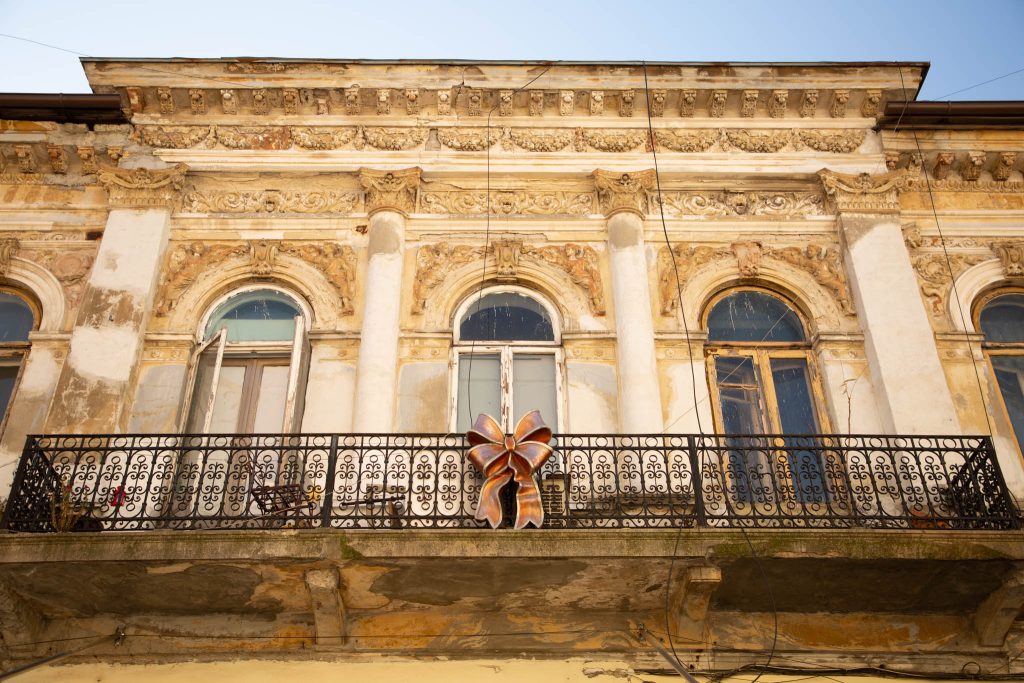
We left the Old Town via the Pasajul Maccca – Villacrosse, a beautiful passage shrouded in a stained glass window. Featuring little cafes and shops, this is a great place to stop for a cup of coffee and a bit of people watching.
Bucharest’s Modern History
After exploring Bucharest’s Old Town, we headed to a part of the city that showcases a very different side to Bucharest: its Communist past.
Walking (great distance) across the city with our guide (next time, I’d probably jump on a bus or grab an Uber), we arrived in the upmarket Primăverii neighborhood. Here, tucked away on an exclusive street, lay the former residence of Nicolae Ceaușescu – Romania’s infamous and much loathed communist dictator.
Known locally as the Spring Palace, this enormous villa was closed to the public for decades. Eventually re-opened, the villa now offers visitors a rare glimpse into the lavish life of a man happy to deny his country of food, all whilst surrounding himself with gold-plated décor.
The home, filled with gifts from world leaders (including our very own Margaret Thatcher), boasts a cinema, an intricately decorated spa and indoor pool, a private hairdressers and an enormous dressing room filled with Elena Ceausescu’s designer shoes and furs (including some very fetching Chanel suits).
Tours are guided, so you can’t roam free, but it is still a fascinating insight to the private life of this now much despised Romanian leader.
Closed on Mondays, but open the rest of the week, you can visit the Villa between 10 – 5pm, with each tour lasting around 45 minutes.
Tickets will set you back around 65–70 lei (approximately £11–£12).
Revolution Square
Following our nosey around this opulent house, we then (fittingly) headed to Piata Revolutiei – Revolution Square – to hear about the eventual downfall of Ceausescu.
It’s here that the dictator stood on the balcony of the (still standing) Central Committee building, to give a speech condemning the recent uprising in Timisoara. In the square were already some 10,000 protestors – workers, university students and bystanders – who grew increasingly angry as his speech went on. Eventually, Ceausecu and his wife were forced to flee the balcony by helicopter, before being later captured trying to flee the country.
Days later, they were executed.
The square now features several statues in honour of this revolution and is a great place to get a sense of the city’s most recent history.
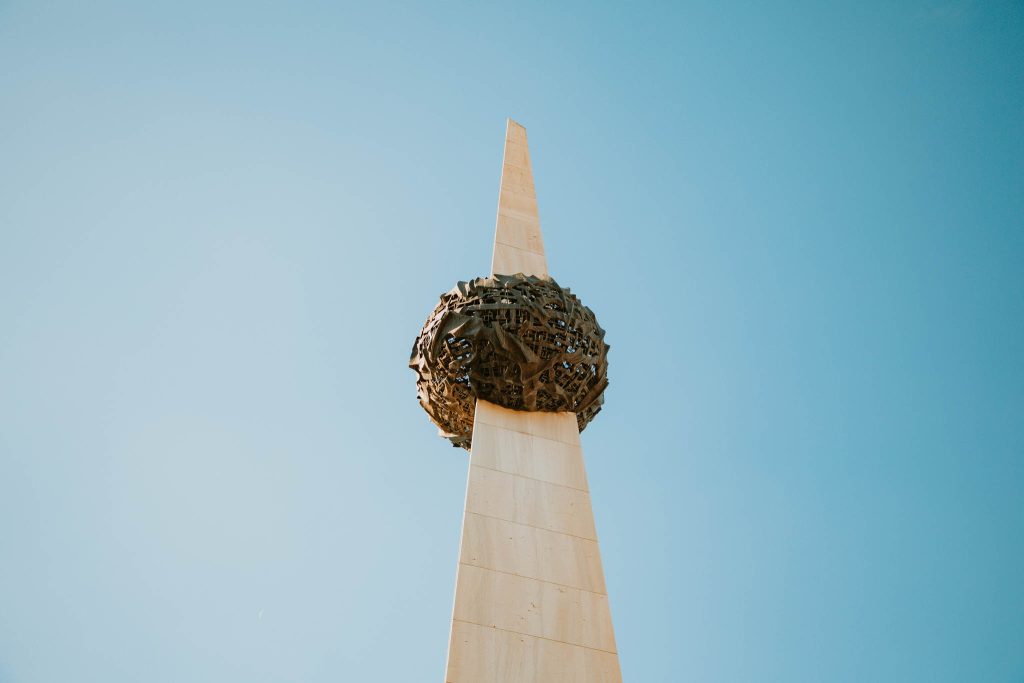
A Cosy Dinner in Bucharest
After a very long day pounding the pavements of Bucharest, it was time to wind down with a dinner at the homely Lacrimi si Sfinti.
Serving traditional Romanian dishes, this welcoming spot is decorated with references to farming and agriculture; think little cockerel figurines on shelves and paintings of pastoral Romania.
We loved this restaurant and it was easily one of our top restaurants in Bucharest (and not too expensive at all). Be sure to try their sweet cheese pie for dessert, or their bursting-with-flavour plum dumplings.
Meat-based main meals cost around £8-£10.
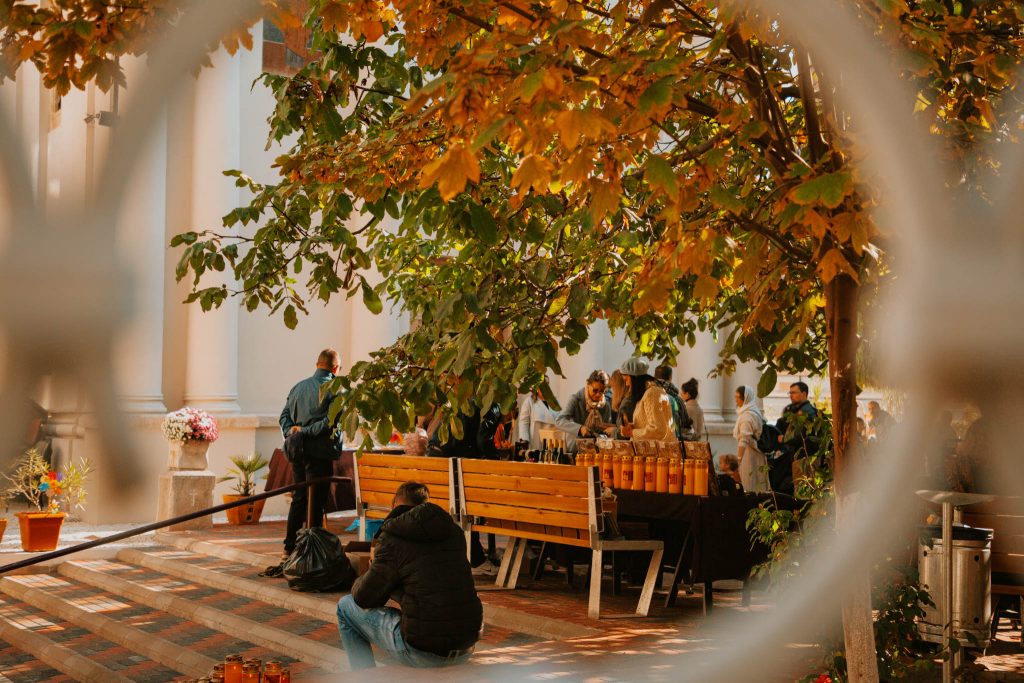
Day 3: Leave Bucharest for Brasov
So, what’s next on this 7 day Transylvania itinerary? And where are the best places to visit in Transylvania?
After a somewhat tedious tour of the Parliament of Palace (would I visit again? Probably not – it’s grand, but each room appears almost identical), we jumped onto our mini bus for our drive from Bucharest to Brasov.
It was time to explore Transylvania.
How Long Does it Take to Drive from Bucharest to Brasov?
Driving from Bucharest to Brașov, on paper, should take between 2.5 – 3.5 hours (the distance is around 170km). The route is very pretty – especially during autumn – and takes you through Sinaia and the stunning Carpathian Mountains.
However, this route follows the DN1 (or E60) – a notorious road that can get very, very congested.
As such, our own drive from Bucharest to Brasov took nearly 6 hours.
An easier way to get from Bucharest to Brasov might therefore be by train. Four train providers offer a regular service throughout the day, with upwards of 30 departures daily – and the journey takes around 2 hours 15 minutes (if you take the fast train).
Places to Stop Between Bucharest and Brasov
Nevermore Academy
Aside from a couple of service station pit stops, we tried to just keep going on our own road trip through Transylvania. However, one very cool place we did pause at was the set from the Netlflix show, ‘Wednesday’ – and the iconic ‘Nevermore Academy’.
The exterior of the Academy is in fact the beautiful Cantacuzino Castle, found in the small village of Busteni, nestled in the Carpathians. Handily, it’s also located between Bucharest and Brasov.
Excitingly, the castle is open to the public for guided tours and there’s a restaurant onsite, too. Given we were undertaking our very own Transylvanian road trip, a visit here felt very apt and seasonal.
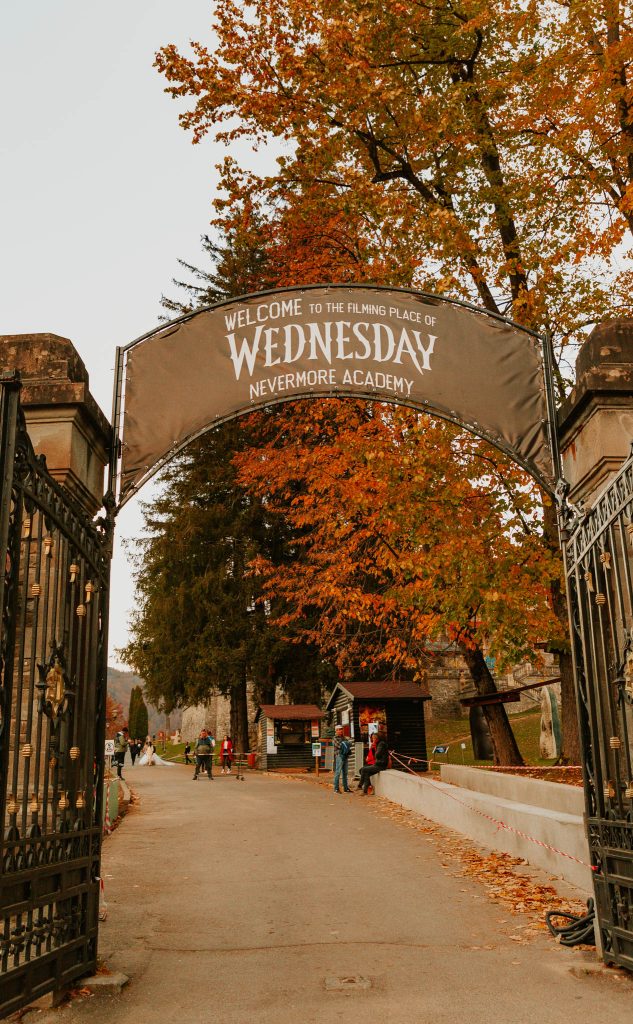
Peles Castle
A gorgeous place to stop between Bucharest and Brasov is the famous Peles Castle.
Unfortunately, as we were trying to fit this itinerary into just 7 days, we didn’t have time to stop at this icon of a building – but really wish we had.
Found in Sinaia, around half way between Bucharest and Brasov, work on Peles Castle began in 1873 and it was originally used by King Carol I as a summer residence. Its setting is beautiful – showing off the deep, green forests of Prahova County, alongside its surrounding snow-capped mountains and picturesque villages.
This castle, with its Neo-Renaissance style – is like something out of a fairytale. It’s filled with hidden doorways, a vast library full of rare books and gorgeous gardens. It’s open Wednesday – Sundays and costs around £8 to get in (taking photographs inside requires a separate fee).
Sinaia Monastery
If you’re stopping in Sinaia, then be sure to also visit this historic monastery.
Wonderfully peaceful, this small monastery remains active – with monks living, working and praying here. Featuring The Old Church, built in 1695 – built to mimic the monastery found in Egypt – and The Great Church built in 1842, this is the place to come for a bit of reflection and calm.
Best Place to Stay in Brasov
After six hours of travel, we eventually arrived in Brasov – by which point, the sun had set and a slight chill hung in the air.
Now officially in Transylvania, it was fitting to learn that the nighttime streets of Brasov are regularly stalked by bears -hungry and curious after a day in the mountains (don’t worry, they largely mind their own business). It all felt fabulously atmospheric and we were absolutely buzzing to be in Transylvania.
We checked in immediately at (what I think is) the best hotel in Brasov: Grand Hotel Belvedere.
This was probably my favourite hotel during our 7 day Transylvanian road trip and definitely the most luxurious – featuring a gorgeous indoor swimming pool and spa, alongside panoramic views of the mountain range surrounding Brasov (an outdoor pool also opens during the summer months).
Dependent on when you visit, a double room will set you back between £92 – £213 a night. This hotel is a great place to base yourself in Brasov and a 10 minute walk into the Old Town (albeit, the walk back will take you up a very steep hill).
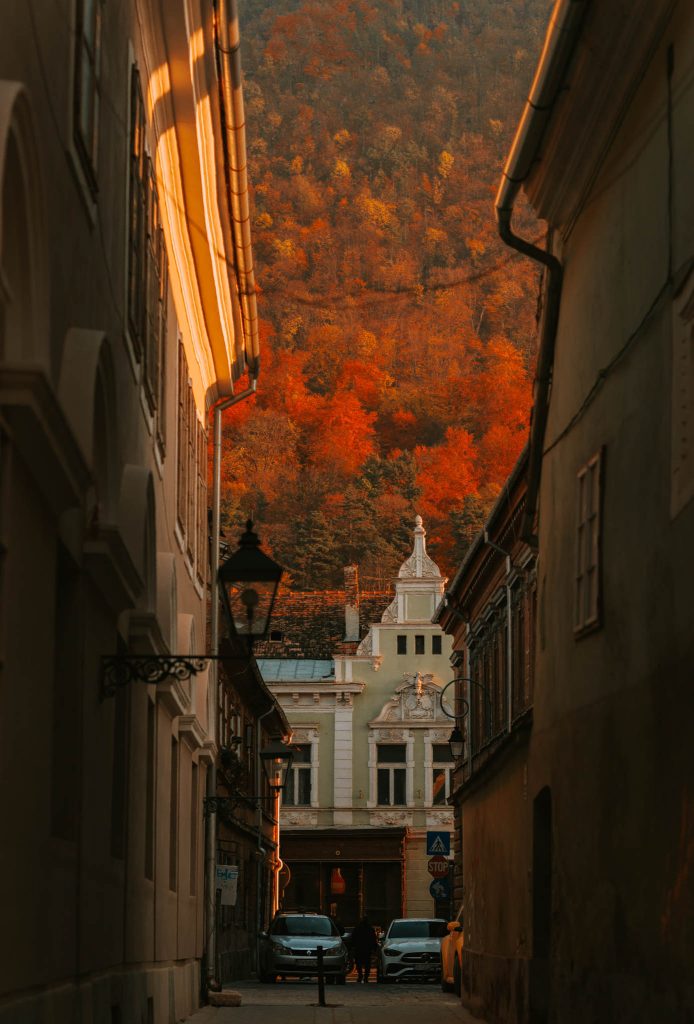
Best Place for Dinner in Brasov
During our own two night stay in Brasov, we ate at a couple of fantastic restaurants and wine bars.
On our first evening, we headed straight to Bistro de l’Arte – a cosy wine bar in the heart of Old Town Brasov. This is a great place to sample some Romanian wine – largely from the Transylvania region, alongside some delicious European and Romanian food (definitely try the crispy cornflower pancake, with sausage and local fermented sheeps’ cheese).
On our second night in Brasov, we went to the equally brilliant Sub Tampa – snuggled at the bottom of the mountains. A very classy restaurant, Sub Tampa focuses on providing updated and modern Transylvanian cuisine – including bear meat, piglet, lamb leg and beef tongue.
Day 4: Explore Brasov and Visit Bran Castle
Although we had only just arrived in Brasov the night before, our first morning in Transylvania would be spent visiting the infamous Bran Castle – the inspiration behind Count Dracula.
Visiting Bran Castle from Brasov
A good reason for including Brasov on your Transylvania road trip itinerary is because it’s a very short drive to the region’s biggest tourist attraction: Bran Castle.
If you’re traveling through Transylvania, you have to visit this (albeit over-hyped) spot. Visiting this gothic fortress is almost a rite of passage for anyone drawn to the legends, landscapes and eerie allure of Romania’s most famous region.
Bran Castle is often marketed as ‘Dracula’s Castle’ – the place that inspired Bram Stoker to write about the world-famous blood drinker. However, and while Bram Stoker never visited Romania, and the historical Vlad the Impaler (who inspired Dracula) never lived in the castle, this somewhat tenuous association endures thanks to the fortress’s amazing silhouette and setting.
Originally built in 1377 by Saxon settlers, Bran Castle has been a royal residence, a military fortress and a customs post between Transylvania and Wallachia. It also briefly housed Queen Marie of Romania, one of the country’s most beloved monarchs.
Today, it’s a museum filled with royal memorabilia, medieval artefacts, and – sometimes clumsily placed – Dracula lore.
Although Bran Castle is no doubt a brilliant sight, we found that the sheer number of tourists diluted the magic.
We arrived around 9am, hoping to beat the rush. However, even then, we found ourselves waiting 30 minutes just to get inside. Once you’re in, we realised it would be a (very) slow shuffle through narrow corridors and steep staircases, hemmed in by a constant stream of visitors. We found ourselves often moving with the crowd, which made it hard to pause and take in the atmosphere (or even a decent picture).
I’d therefore advise you avoid Halloween if you can – especially as the castle looks particularly beautiful during the height of summer.
Adult tickets will set you back approximately £11.
Visit a Cute Cafe in Bran
Around the grounds of Bran Castle is an open-air museum, showcasing traditional Romanian peasant architecture from the region. It’s an additional £11 to enter, but honestly, well worth it. I actually preferred peacefully walking around these buildings than visiting the castle itself.
Following this, we headed to the very homely Gingerbread House cafe, close to the Castle. Bran itself is a very small village and this is one of the lesser tourist filled spots. Here we enjoyed huge mugs of steaming hot chocolate and an assortment of homemade ginger bread cookies, made in a variety of shapes.
It was a really sweet spot and a great place to decompress after battling the crowds at Bran Castle.
Is Bran Castle Really Worth Visiting? My Honest Opinion
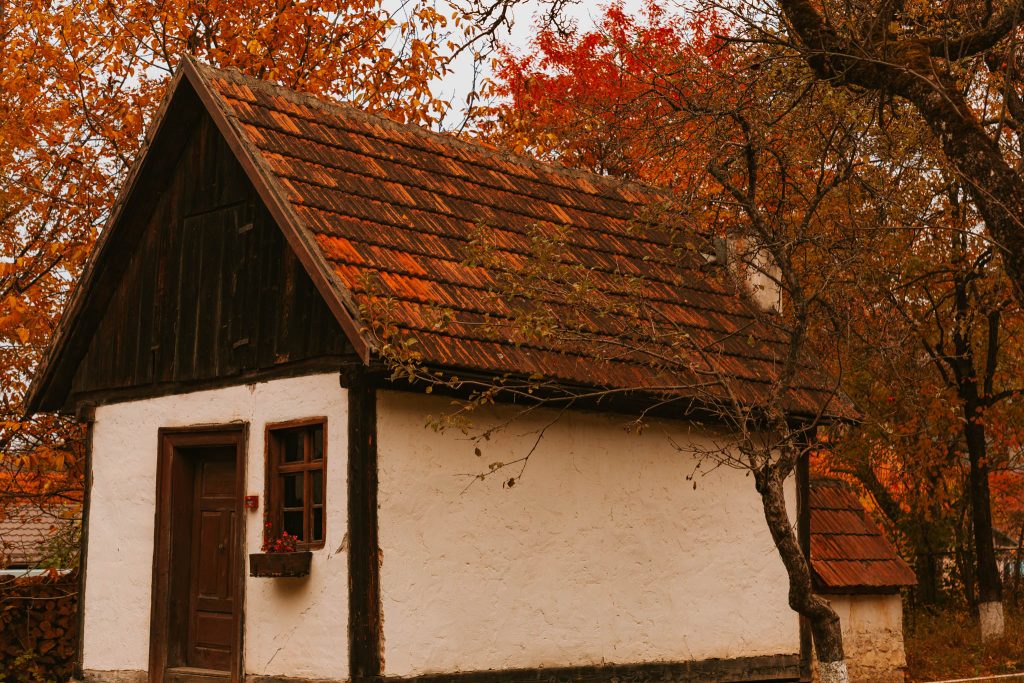
Return to Brasov to Explore
After our obligatory visit to Bran Castle, we headed back to Brasov, so that we could finally explore this famous city.
I’ve written a fuller guide to Brasov here, but in short, it’s one of the most beautiful cities in Transylvania – and definitely a spot to include on your 7 day Transylvania road trip itinerary.
Blending natural beauty with historical charm, Brasov is filled with cobbled streets, medieval architecture, and a stunning mountain backdrop, thanks to the Carpathian Mountains.
The city’s heart is the Council Square (Piata Sfatului), lined with gorgeous Baroque buildings and dominated by the iconic Black Church—one of the largest Gothic structures in Eastern Europe.
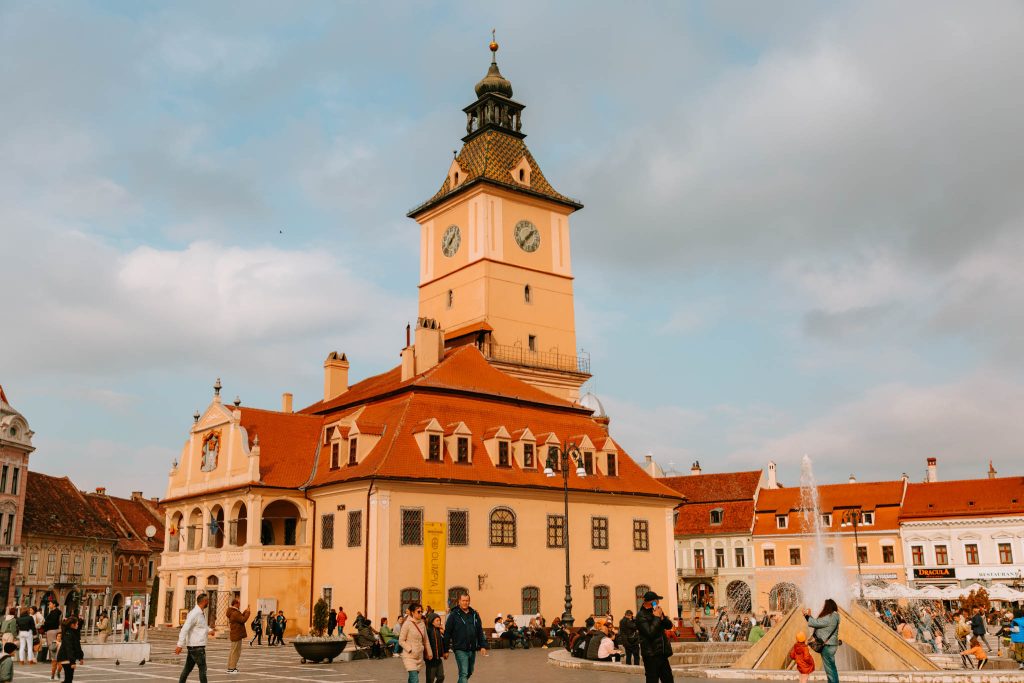
We were bowled over by Brasov. It feels like a city you might find in Germany or France – filled with sophisticated bistros and wine bars, and steeped in its own unique history.
If spending a day in Brasov, I would highly recommend heading to the historic White and Black towers – which offer incredible views across the city. Likewise, the ‘Black Church’ is well worth dropping by. Inside is an enormous organ, with over 4,000 pipes, and a collection of ancient tapestries.
An organ player is regularly there and plays for the public – it’s quite the spectacle.
In the summertime there is also a cable car that runs from Brasov up the looming 940 metre mountain overlooking the city. Once at the top, you can take one of the many hiking trails available, or simply enjoy a coffee and the views across the Carpathian mountain range.
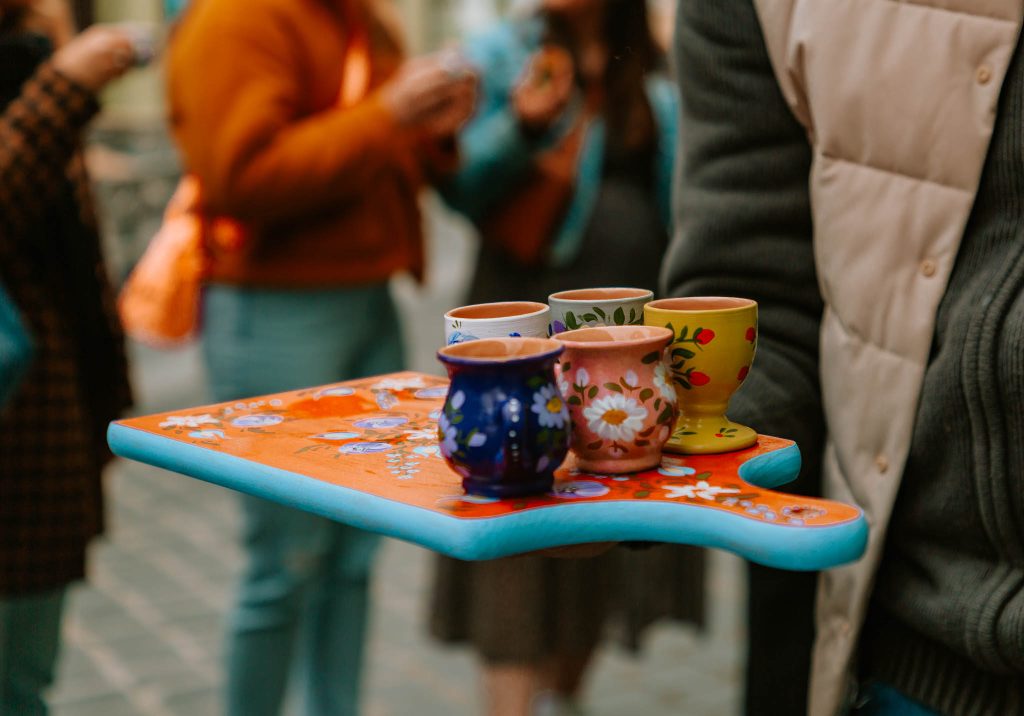
If you’re looking for a cute and cosy cafe in Brasov, definitely head to La Vatra Ardealului for a slice of delicious cake. The cafe has a very vintage and homely feel, and is a great place to refuel after a day of exploring.
Read more about how to spend a day in Brasov here
Day 5: Brasov to Sighisoara, via Viscri
After two nights in Brasov, is was time to continue with our Halloween road trip through Transylvania and head to our next stop: Viscri (another of the best places to visit in Transylvania).
Visiting Viscri
If you’re driving between Brasov and Sighisoara (our final stop that day), then stopping at Viscri is a must.
A 1 hour 30 minute drive from Brasov (take the DN13/E60 route), Viscri is ensconced amongst Transylvania’s greenest, pastoral landscape. If you are making this journey by train, then it’s a little trickier – you’ll need to take a train from Brasov to Rupea, followed by a taxi to Viscri (around 12 miles).
Is Viscri Worth Visiting?
Viscri is, essentially, a very small, agricultural village – nestled amongst farmland and rolling fields. You might therefore be wondering – is Viscri worth viting?
Yes – and for one very surprising reason.
Viscri is a step back in time—an idyllic Saxon settlement with cobbled streets, whitewashed houses, and a UNESCO-listed fortified church. While once barely visited, Viscri gained international attention thanks to King Charles III (then Prince of Wales), who fell in love with the heritage and simplicity of this little idyl.
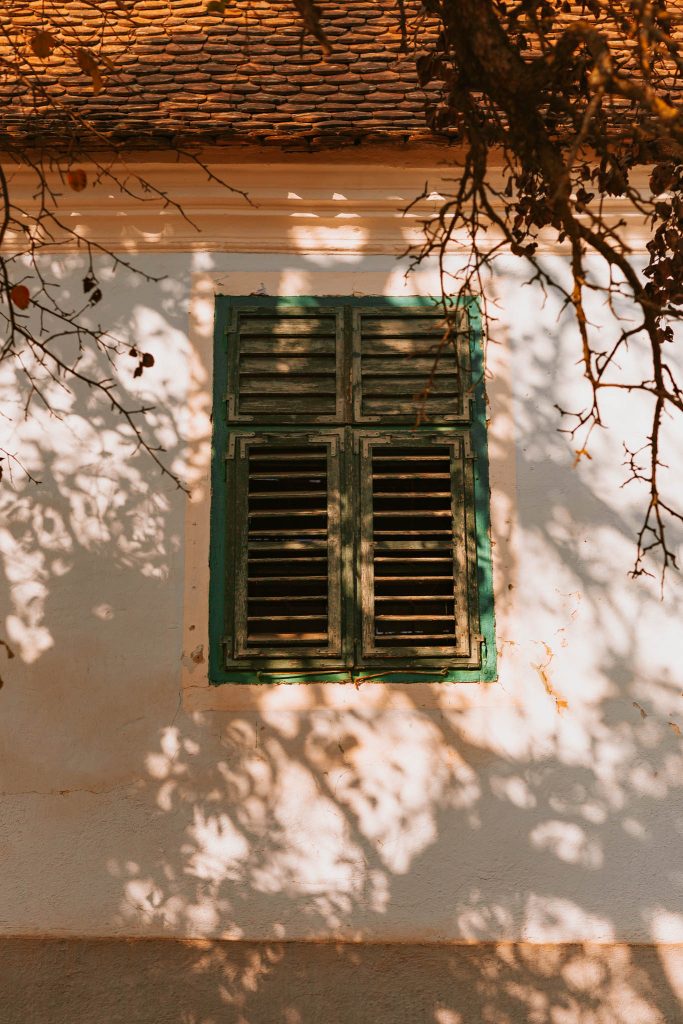
With a penchant for preserving rural traditions, Charles decided to purchase and restore a traditional Saxon home in Viscri (which is now open to the public). This brought with it a lot of interest and, in turn, sparked the revival of traditional craftsmanship, eco-tourism and sustainable agriculture in the wider region.
Today, Viscri is the proud flag bearer for rural conservation across Romania.
Our own journey into Visci highlighted just how wedded to local traditions this area of Transylvania is. Horse and carts regularly passed us by – towering bales of hay tottering on the back – while wild horses galloped in the fields alongside them.
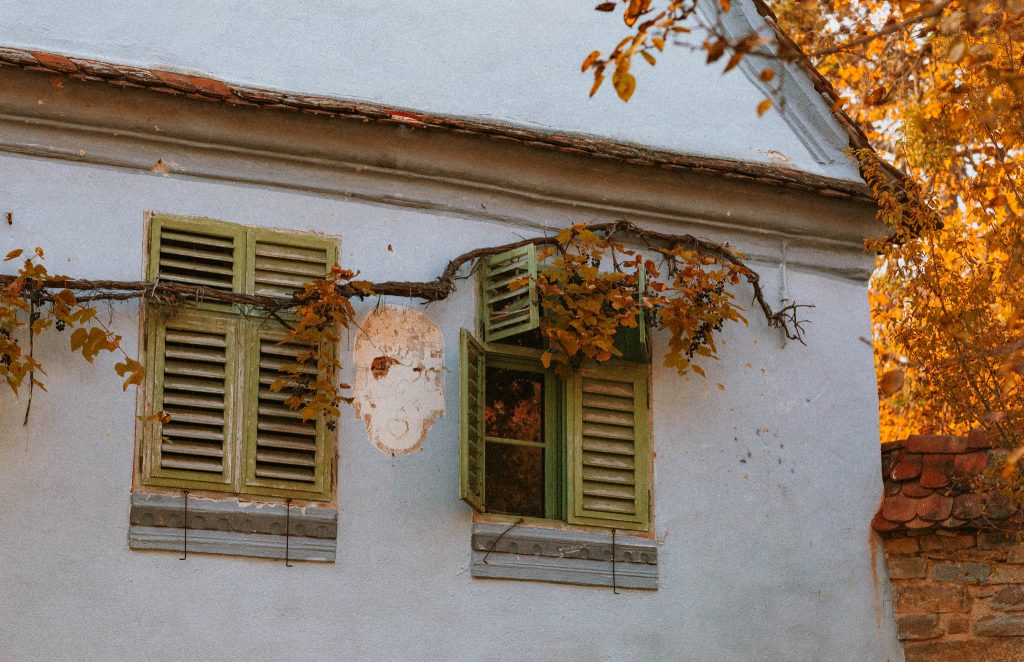
When we arrived in Viscri, around midday, it was like stepping into a film set.
Incredibly peaceful, filled only with the sound of sheep, bird song and the creaking of a cart wheels, this tiny village was like stepping off the urban hamster wheel. Sheep dogs roamed freely and chickens clucked gently around our feet – scratching at the dirt.
I immediately understood why our very own King was just so taken with this place.
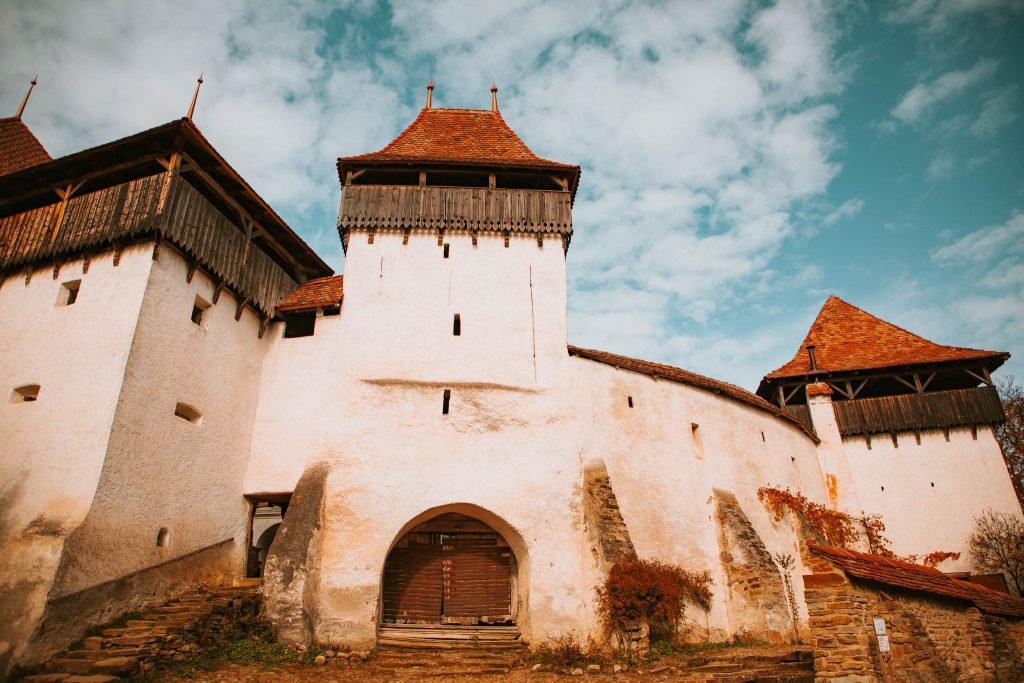
Viscri’s UNESCO Protected Fortified Church
One of the top sights in Viscri, its fortified church, has served as the centre of this village since the 12th century.
A famous example of Transylvanian Saxon architecture and one of the best-preserved fortified churches in Romania, I was really looking forward to visiting this impressive part of Viscri. Originally built as a small Romanesque chapel, the church was later expanded by Saxon settlers – offering a refuge for the entire village.
When we visited, we had it largely to ourselves – an oasis of flowers, ancient structures and artefacts. Inside the church we found ancient, preserved wooden pews, a hand-painted altar, and a small museum showcasing traditional tools and textiles. I loved this museum – and it provided a brilliant insight into rural life in Transylvania throughout the centuries.
If you climb the church, you’ll be treated to some lovely views of the surrounding countryside. When we visited, one sun-drenched autumn day, bonfires quietly burned in the fields as horses brayed and woodpeckers flew back and forth.
It was utterly idyllic.
Tickets to enter cost around £3 – £4.
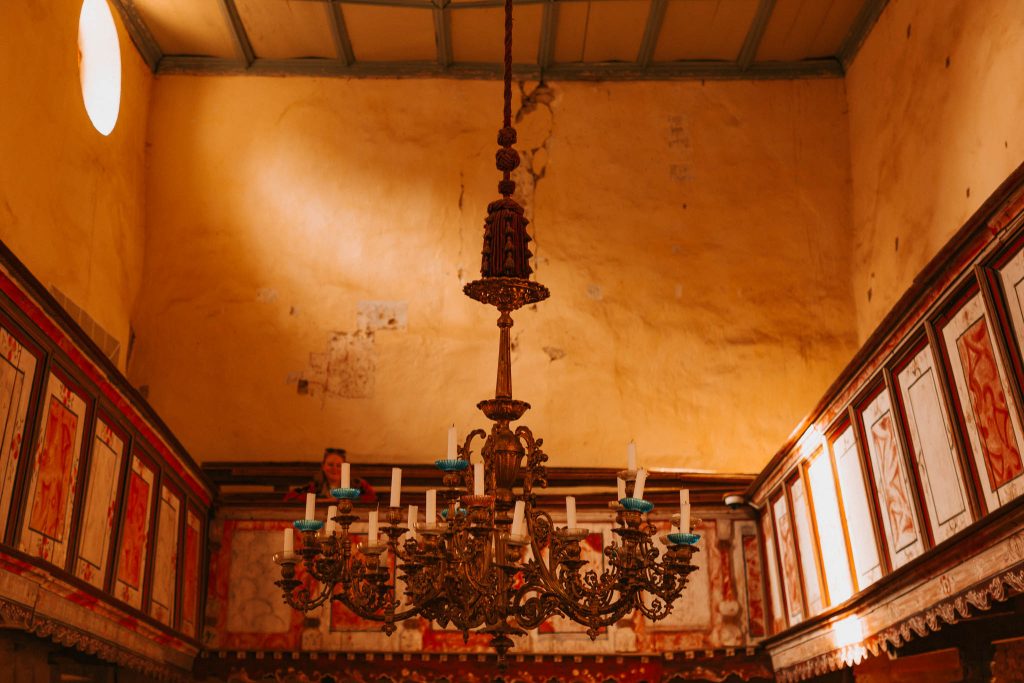
King Charles III Home
ChatGPT said:
Onwards to Sighisoara
Once you’ve explored Viscri, it’s time to complete the short distance to Sighisoara.
Found in the very heart of Transylvania, Sighisoara is one of Europe’s best-preserved medieval towns. It also happens to be one of the best places to visit in Transylvania – and the most beautiful.
With its cobbled streets, pastel-coloured houses, and the iconic Clock Tower watching over it, Sighisoara blends history, charm, and just a touch of legend (it’s the apparent birthplace of Vlad the Impaler — the inspiration for Dracula).
Funnily enough, we hadn’t given much thought to visiting Sighisoara – instead vaguely fixated on bumping into our very own King in Viscri.
However, it turns out that for many, Sighisoara is the highlight of any road trip through Transylvania.
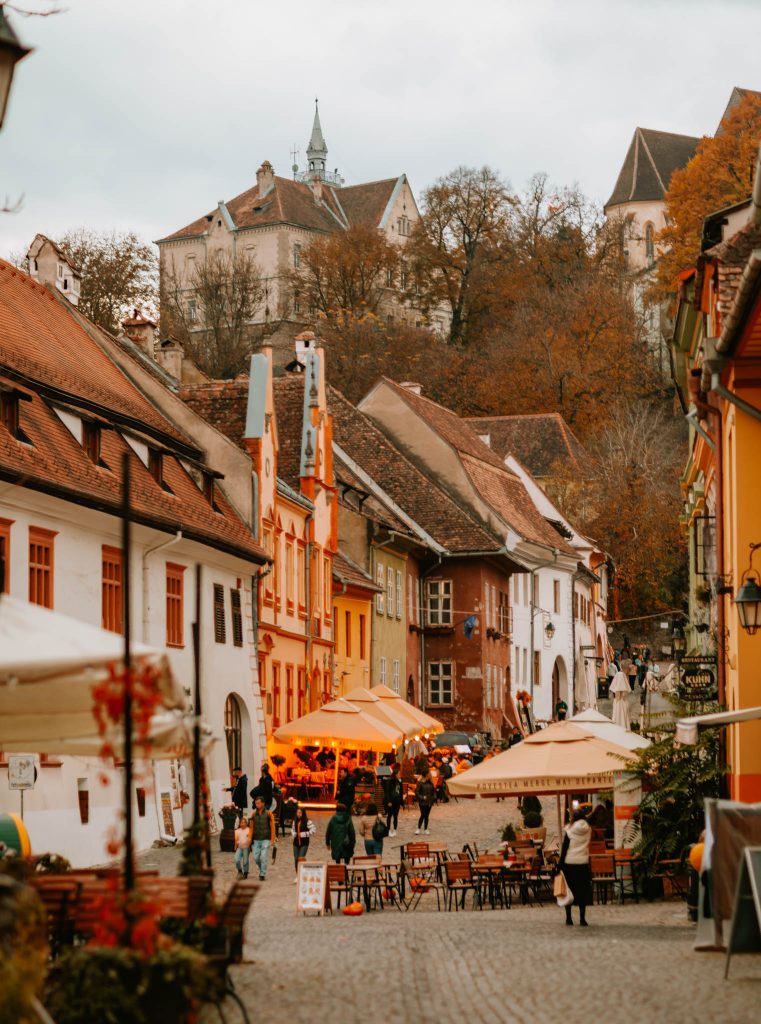
Firstly, in terms of where to stay in Sighisoara – we stayed here and loved it. We thought it was fantastic value and while a little old fashioned in parts (lots of faux opulence), it was incredibly comfortable.
As soon as we checked in, we headed to see a few of Sighisoara’s key sights.
These included Sighisoara’s ancient clocktower (wait for it to strike the hour and enjoy the spectacle), a visit to one of its many towers (each belonged to a certain guild, so has its own story and style) and a walk up to its ancient Anglo Saxon cemetery, via the city’s famous Scholars’ Staircase.
Although there aren’t masses of things to do in Sighisoara, part of its charm is just wandering its cobbled lanes, photographing its colourful houses, exploring its artisan shops, and enjoying coffee in a cosy cafe.
If you’re visiting in July, the Medieval Festival brings the entire town to life with music, costumes, and performances – and is well worth attending.
We spent just one night in Sighisoara and to be honest, felt this was probably enough. It’s beautiful, but small, and a great place to stop when planning an itinerary for a Transylvanian road trip.
Read more about our one night in Sighisoara here
Day 6: Sighisoara to Cluj Napoca
The last part of our Transylvania road trip took us from Sighisoara to the unofficial capital of Transylvania – Cluj Napoca. We (reluctantly) left Sighisoara early in the morning and after an uneventful two hour journey, arrived in Cluj in time for lunch.
Vastly different to the sleepy towns of Transylvania, Cluj is a large and vibrant university city – filled with great restaurants and bars, grand squares and a booming night life.
We would be staying for just one night in Cluj and stayed on the outskirts of the city, in this budget-friendly, but grandly-named, hotel – the Grand Hotel Napoca. It’s pretty cheap and has a basic corporate style, but was a comfortable and clean place to stay.
Once we’d checked in, we headed straight out for a walking tour of the city. I’d definitely recommend you take a tour if you can, purely due to the size of the place.
The second most populous city in Romania, Cluj spans a whopping 69 square miles. It’s therefore probably a good idea you don’t just wander too aimlessly, as you might miss the main sights – and some parts are largely residential.
To kick-start the tour, we gathered in the very European-feeling Piata Muzeului (square). With the autumn leaves swirling around our feet, baroque buildings standing over us and the scent of roasted coffee beans in the air – this square might just as easily have been found in Paris or Vienna.
After grabbing a (great) coffee from Olivo Coffee Culture, our tour began – weaving through the university backstreets and hangouts of Cluj Napoca.
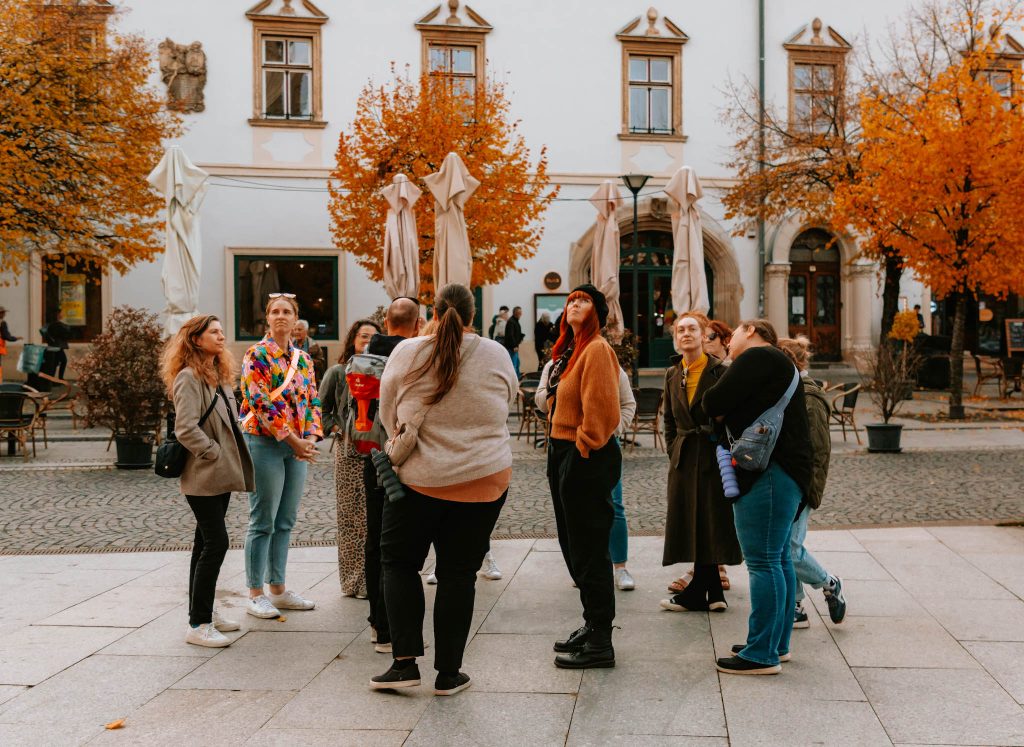
This city has all the history of the rest of Transylvania, yet somehow feels entirely different. Chic, busy and distinctly modern, I initially felt a little like a fish-out-of-water. Compared to the quiet streets of Brasov, or the stillness of Viscri, Cluj was a bit overwhelming.
Nonetheless, we ploughed on – keen to see the more historical parts of the city.
These parts included a visit to the striking Piata Unirii, the city’s central square, overshadowed by the Gothic-style St. Michael’s Church and the statue of Matthias Corvinus (one of Romania’s most important historical figures). This large area is also surrounded by beautiful buildings and cosy cafes, and again – felt very European.
Cluj Old Town
From here, we headed to Cluj’s Old Town, which I immediately preferred to the more modern parts of the city.
Here, the slim, tall buildings were painted an array of pastel colours and university students quietly duck in and out of wooden doorways, attending tutorials. It felt almost a little bit like Oxford or Cambridge – a scholarly sort of place.
Definitely be sure to explore the cobbled streets around the Old Town, including Strada Memorandumului and Strada Iuliu Maniu. Likewise, on Strada Potaissa there is a fantastic open-air flower and book market, while Strada Mihail Kogălniceanu is a great place to spot Franciscan architecture.
This area really comes alive at night, as fairy lights illuminate the streets and jazz bars overflow with customers – so I’d definitely recommend returning once the sun sets.
Cluj is also home to plenty of green spaces, including its popular Central Park and the beautiful Cluj Botanical Garden (I really liked the Roman-inspired area, in particular).
Cosy Cafes in Cluj
One of our favourite things to do (on any trip) is to park ourselves in a cosy cafe and enjoy a cup of coffee.
Thankfully, Cluj is home to plenty of welcoming spots to do just this – including Narcoffee Roasters, Cafeneaua Francesca (great if you love tea) and YUME Coffee Roasters.
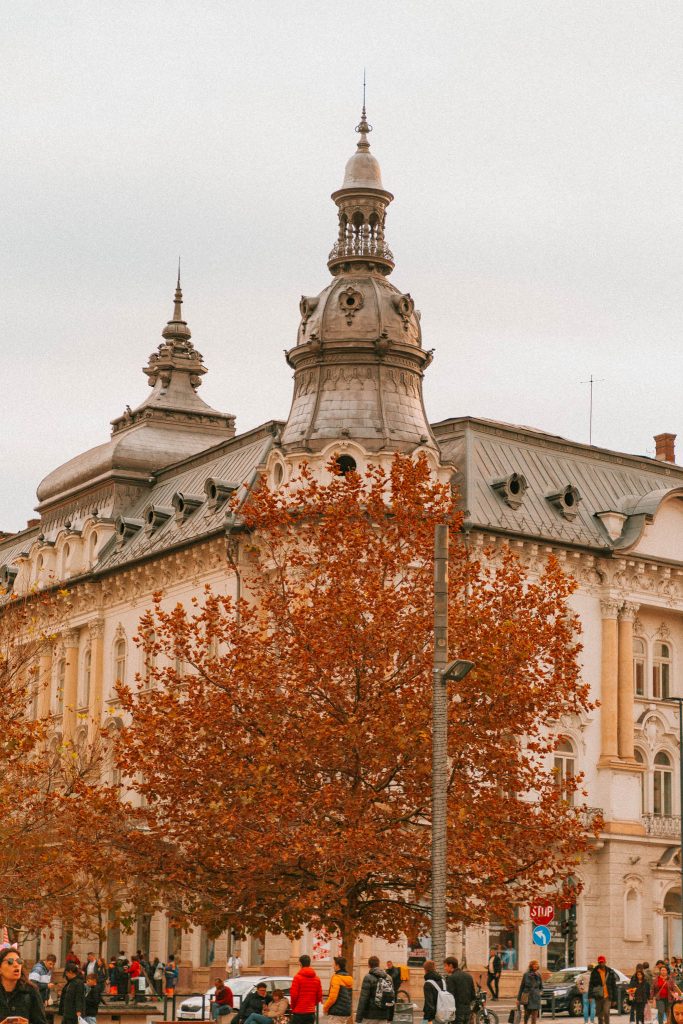
Cluj Nightlife
Cluj is a hotspot for festivals and nightlife.
As the hot summer nights roll around, events like the internationally known Untold Festival, kick off. The Electric Castle Festival, offering an eclectic mix of music in a historic setting, is also very popular.
In terms of the best bar to head for a drink in Cluj Napoca, you’ll be spoilt for choice. A few mentioned by our guide were the After Eight Cocktail Club (think, European night club), The Soviet (right up my street – offering a tongue-in-cheek nod to Soviet culture), Joben Bistro that offers some great cocktails and has an eclectic Victorian steampunk interior, Insomnia Café & Bistro (super artsy and hipster) and The Brewhouse, for craft beers.
Salina Turda
If you have time on your week long Transylvania road trip, definitely make time to visit the mystical and awe-inspiring Salina Turda.
Bizarrely, this cavernous place is a (now flooded) old salt mine turned tourist attraction, and even has underground amusement rides. I saw so many dystopian reels about this place and would have visited, if we’d had the time.
I wouldn’t say it’s beautiful, but it’s definitely a unique thing to do in Transylvania. Tickets cost around £14 for an adult, if visiting at the weekend.
Read our full guide to Cluj-Napoca here
Day 7: Cluj Napoca (Back) to Bucharest
After our one day in Cluj Napoca, it was time to get up and fly back to Bucharest – for the final day of our 1 week Transylvania road trip itinerary.
I think just one day in Cluj was more than enough and to be honest, we probably only visited Cluj for its transport facilities – as we could easily fly back to Bucharest (alternatively, you can fly straight back to the UK from Cluj).
If I had my time again, I’d perhaps skip the day in Cluj and instead visit Sibiu in Transylvania, which is located between Brasov and Cluj. One of the prettiest towns in Transylvania, I think this would have probably been a city we’d have enjoyed more – if I am being totally honest.
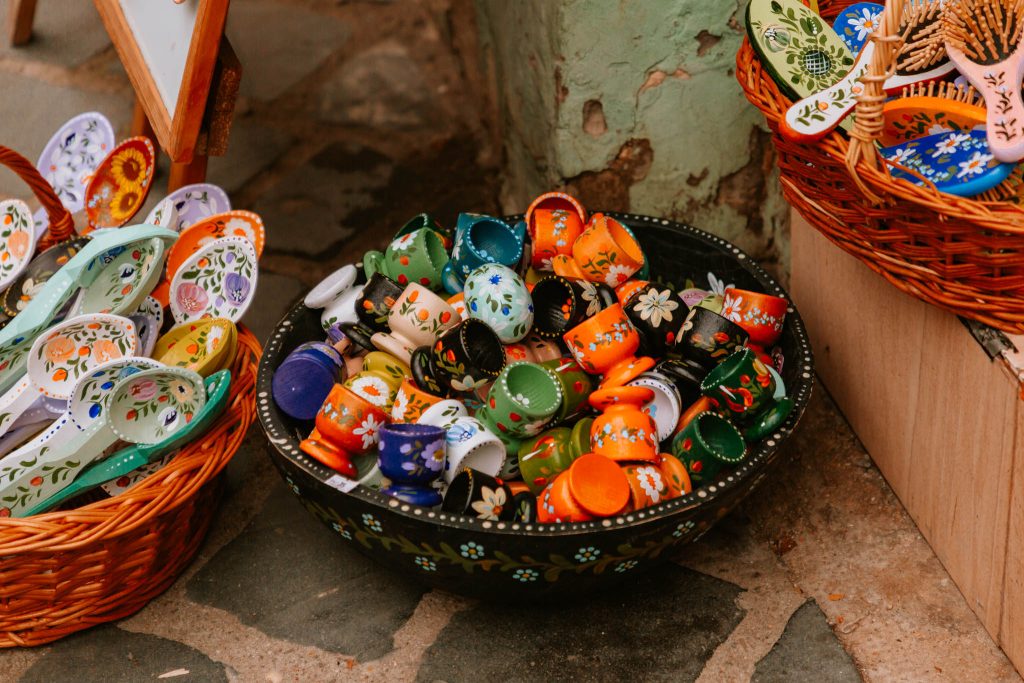
However, as we wanted to return to Bucharest, so that we could visit the Therme Spa and do a last bit of sightseeing, visiting Cluj worked out fairly well.
After taking a very quick flight back to Bucharest (under an hour), we headed straight from the airport to Bucharest’s world-famous spa – Therme Bucharest.
Located right next to the airport, we were there with 10 minutes and ready for a day of relaxation and pampering. Indeed, after a busy week on the road, we couldn’t think of a better way to finish this Transylvania road trip than by floating in the hot, mineral-rich waters of the Therme Spa.
However, and as you can read more about here, we were actually very disappointed with the Therme Spa. Hot, hugely overcrowded and noisy, this was far from the relaxing experience we had hoped – and we even left early.
I’ll caveat that we did visit during school holidays, hence the crowds, and so you may have a more enjoyable experience if you visit outside of peak hours. However, from what I’ve read online, due to the relatively cheap cost of the spa and the endless social media promotion surrounding it, our experience was not an isolated one.
After the spa – which was an all day affair – we checked back into the same hotel in Bucharest where we started, preparing for our final dinner of the road trip.
With just a final chance to view a few more parts of Bucharest, including the gorgeous shops found close to the former Ceausecsu residence, we soaked up our final few hours in Romania – enjoying the last rays of autumn sunshine.
It had been a brilliantly unexpected week – one filled with more beautiful sights than scary experiences – and as we enjoyed our last meal together, we reflected on just how underrated Transylvanian – and indeed – Romania is as a destination.
Ultimate 7 Day Halloween Transylvania Road Trip Itinerary: Final Thoughts
After our 7 day road trip through Transylvania – including the cobbled streets of Brasov, the silhouettes of Bran Castle, the timeless Viscri, the charming sights of Sighisoara, and the lively Cluj Napoca — one thing was clear: Transylvania is far from the eerie myth people expect.
If you’re planning this trip around Halloween, you might arrive hoping for mist, ghosts and gothic chills — and honestly, you might be a little disappointed. Instead, what you’ll find is something far more surprising (and lovely): a land of tranquility, charm, and cinematic scenery.
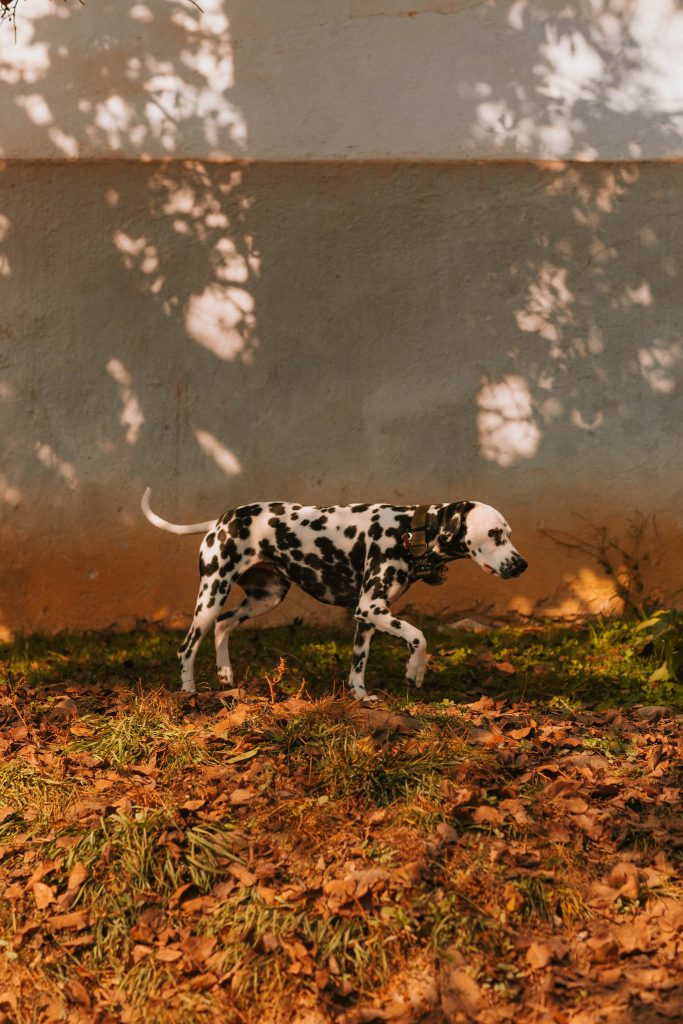
For me, the real magic was in the stillness of Viscri, the towering mountains around Brasov and the joy of sitting in Sighisoara’s town square, eating papanasi.
Transylvania isn’t a horror story – it’s a slow and stunning place, filled with fortified churches, winding roads and understated hospitality. This area of Romania invites you to let go of your expectations and instead enjoy Romania for what it really is: charming, loaded with history and full of the most incredible scenery.
It wasn’t the Transylvania road trip we were expecting, it was, truthfully, even better.

























